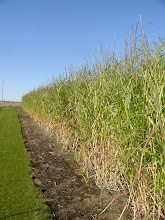The corn ethanol industry is at a very exciting and scary point. We know the capacity is nearing the 10% blend wall but we also know that the blends can be increased over time. (Brazil) We know there are better renewable alternatives to ethanol but they have not obtained commercial scale production.
What will the future look like for these companies and their facilities? It depends on many factors but they will have one thing in common. These facilities will be producing products for many years to come. It may not be ethanol from corn. It may not be ethanol at all. But it will be renewable fuel, chemicals, and other products.
Let's just take a look at corn ethanol. Not so many years back a typical ethanol plant was located with reasonably priced corn, steam energy, electricity, water, transportation, etc. The plants were designed to make ethanol and either wet or dried distiller's grains. The plant may or may not have captured the CO2 depending on the local market. It was a pretty standard model duplicated some 150+ times across the US.
The ethanol plant today is affected by GHG emission legislation, indirect land use, water use, and increasing economic pressures. The corn ethanol plant of today uses advanced equipment to reduce energy consumption, water usage, is developing other valuable products, and is investing in upgrades to improve their efficiency. Water recycling, oil extraction, anaerobic digestion, and other changes are helping to increase the value these facilities are extracting from each bushel of corn and do it more efficiently. This is a sign of an industry which is maturing. It is a good and necessary evolution for the industry .
The refining industry did not just appear and operate at their current efficiencies. It has taken many, many years of distillation improvements, bottleneck elimination, and many other developments in the refining industry to get where we are at today. They are still improving! Why would we expect corn ethanol to be any different?
Now let's look to the future for these facilities.
Corn ethanol production stated simply is converting carbohydrates into sugars and turning these sugars into ethanol through fermentation. Why do we use corn? It is an inexpensive source of sugars and has a well established supply chain.
Anyone who has done a nickel's worth of research on cellulosic ethanol knows the first hurdle is getting the sugars released from the material so you can use them. The second hurdle is getting the ethanol produced and extracted at a competitive price to corn ethanol. When these factors are overcome for cellulosic ethanol and other products there is going to be a dramatic change in the ethanol industry.
The production of cellulosic ethanol, biobutanol, and many other products actually use the same types of equipment in many processing steps. When these products are made at an existing corn ethanol facility it makes things very interesting.
Imagine an integrated biorefinery which has the ability to change feedstock AND final products based on availability and pricing. When you combine the flexibility on feedstock and final product you have created a model which allows each facility to take an individual approach to their feedstock and final product choices to maximize their profits based on their specific opportunities. This is an industry transformation which is getting closer every day.
Wednesday, March 17, 2010
The Corn Ethanol Evolution and Transformation
Labels:
advanced biofuels,
biofuels,
cellulosic ethanol,
ethanol,
food vs. fuel
Subscribe to:
Post Comments (Atom)

No comments:
Post a Comment